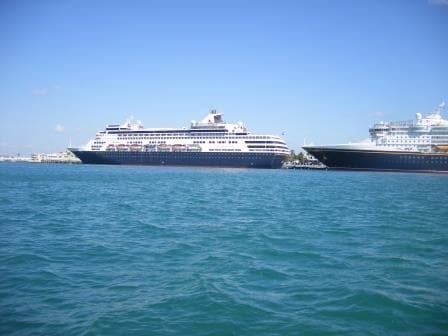It was quite windy when the Ryndam approached the pilot station and that always gives to think about what you will get when you get in there. Luckily the Pilot boat sails by the docks when coming out and its report gives some indication. The 2nd thing is the rule – of – thumb; call it past experience, and it has taught us that the wind at the dock is about 10 knots less than the wind at the sea buoy. Although low laying Key West is not that sheltered, there is still a high enough concentration of obstacles to dampen the wind velocity. That meant that for the day the winds inside would not be more than about 15 to 20 knots and that velocity is not really an issue.
So by noon time the ship had been cleared and everybody streamed ashore to inspect the local scenery. A few guests came back later rather shocked as the local scenery had been a bit more revealing than they had expected. While that was going on, I took the Tender trainee’s down into the water to get the basics of ship maneuvering under control. Key West is a great port to do that, as it is always very busy with Sunday sailors and there is always wind and there is always current. Three ingredients which make a tender driver sometimes question his sanity; about if he really wants to be a tender driver or not.
The traffic in Key West is a mixture of Professionals (the large sightseeing schooners, ferries and catamarans), a group of those who study to become old-sea salts- but have not made it yet. And the largest group, which are the six pack navigators who are let loose with a speed boat or a jet ski after 5 minutes of training. Tender drivers have to learn the Rules of the Road, especially nbrs 1 to 20 and act accordingly. With the training course we teach the trainees to always err on the safe side and to find a common denominator that works the best. As an example; a sailing vessel has most of the time right of way. Not always but most of the time. To make it easier, we teach the tender drivers to give right of way to sailing boats all the time. Why, because a tender is much more maneuverable than a sailing yacht and getting out of the way early and staying out of the way is much quicker for the tender than for a ship that has to tack and relies on the wind.
Today, just staying out of the way, was already hard work. It was breezy but not so much that small craft stayed in and everything that sailed, or somehow gave the impression that it sailed, was out there.
One that gave a lot of discussion was a guy on a sail board who was stopped in the fairway (or drifted into it) and sat on the sailboard fishing with the sail up. So was it a fishing boat, was it a sail boat, what was it according to the Rules? And was he doing in the fairway? As he was just floating, he might even consider himself Not –Under- Command, who knows? After a lot of discussion the Golden Rule was accepted: If you do not know what the other party is going to do, and you can safely do so, stay out of the way. So we did. Then the discussion came up if this guy knew what he was doing?? So I said why don’t you sound the Danger Signal (5 shorts blasts) and see what happens. We did and the reaction was: looking up from his fishing rod, giving a friendly wave and returning to fishing. He did not get the hint at all. So we stayed away. It must give the USCG a real headache when dealing with these sort of people.
Later on in the evening we had to deal with USCG, albeit in a very positive way. Shortly after departure one our guests suffered a stroke and had to be disembarked. When that happens the fastest way to get help is to the USCG. If the USCG doctor at the location SAR Base agrees with the ships physician that it is urgent and help is needed at once; they will dispatch a helicopter. However being that close to Key West a helicopter did not make much sense so Capt. Colm Ryan simply turned the ship around, sailed back to the sea buoy and the patient was off-loaded onto a small USCG cutter. I am happy to report that the patient is doing well in the local hospital.
The hospitals on cruise ships are equipped to deal with regular walk in patients and with controlling an emergency. They are not equipped with supplies to solve the emergency. E.G. If there is a heart attack the medical team will stabilize the patient and keep him or her alive but they cannot take the cause of the heart attack away. That needs specialist help on the shore side. So if there is an emergency on board, the ship’s doctor discusses the situation with the shore doctor to see if a medi-vac is needed or that it can wait to the next port. You do not want to use resources unnecessarily. If it is needed, then the USCG is there very fast. I wonder how many lives have been saved by all these USCG stations around the coast in the course of the years. I have never seen any statistics on it.
Tonight we have an hour forward and then we will spend two days at sea. Sailing north of Cuba through the Old Bahama Channel and then into the North Atlantic. We are expecting sunny skies and the regular trade wind breeze, so it should be beautiful.


Leave a Reply